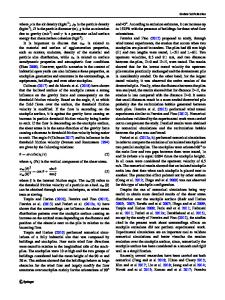Effects of material properties on the mobility of granular flow
- PDF / 4,814,349 Bytes
- 17 Pages / 595.276 x 790.866 pts Page_size
- 71 Downloads / 408 Views
ORIGINAL PAPER
Effects of material properties on the mobility of granular flow Nhu H. T. Nguyen1,2 · Ha H. Bui1 · Giang D. Nguyen3 Received: 13 August 2019 © Springer-Verlag GmbH Germany, part of Springer Nature 2020
Abstract In this study, we investigate the influence of material properties on the mobility of granular flow through granular column collapse experiments using the Smooth Particle Hydrodynamics method and a continuum constitutive model capable of describing the nonlinear responses of granular materials. Numerical simulations are systematically compared with available experimental data and well-established empirical laws to validate the capability of this numerical approach for simulating the dynamics of granular flow. Based on this validation, a series of numerical experiments is conducted to investigate the effects of strength properties (i.e. friction and dilation), density and stiffness properties (i.e. Young’s modulus and Poisson’s ratio) on the run-out distance and energy evolution of granular flows, which were unclear or contradictorily reported in previous experimental studies. We found that as the friction angle increases, the material is less mobilised and hence the run-out distance is shorter. In addition, a denser state (i.e. more dilation) facilitates its mobilisation associated with a greater volume expansion during the collapse. The density and stiffness properties of granular materials, nonetheless, have negligible effects on the deposit morphology and run-out distance of granular flow. To further quantify the effects of material properties, the run-out scaling law of granular flow, which describes the relationship between the run-out distance and the initial geometry of granular columns, is analysed and shown to be significantly influenced by the friction and dilation of the materials. Keywords SPH · Granular flow · Scaling law · Material properties · Friction · Dilation
1 Introduction The gravitational flow of granular materials is greatly related to a large number of natural phenomena and engineering applications such as snow and rock avalanches in disaster prevention and risk management, landslides in slope stability and retaining wall design, handling and transportation of mineral ores in the mining industry, the flow of medical pills in pharmaceutical industry and grains in agriculture. In such applications, one of the essential questions is the prediction of the final run-out distance of granular flow. Elucidation of this question and the fundamental physics of granular flow is not obvious since it exhibits complex behaviour where * Ha H. Bui [email protected] 1
Department of Civil Engineering, Monash University, Melbourne, Australia
2
School of Engineering, Deakin University, Melbourne, Australia
3
School of Civil, Environmental and Mining Engineering, The University of Adelaide, Adelaide, Australia
continuum and discrete behaviour coexist. For understanding the behaviour of granular flow, Lajeunesse et al. [1] and Lube et al. [2] designed a simple experiment
Data Loading...











